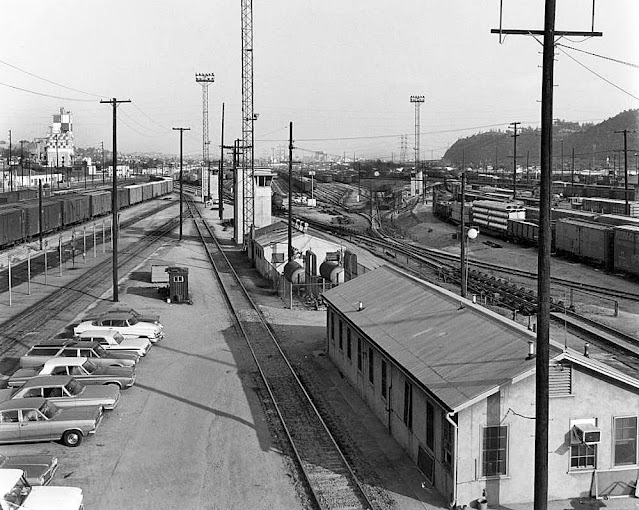1940, Three elderly gentlemen socialize on a bench on top of the Hill Street Tunnel, looking south. The intersection seen below at street level is where 1st Street (only partially visible) meets Hill Street. Cars and street cars are seen traveling north and south.
1945, Looking south from Temple through the streetcar side of the Hill Street Tunnel which was bored through a part of Bunker Hill in 1909 by Los Angeles Pacific (a predecessor of Pacific Electric). It connects Hill Street from First to Temple. A "Private Way for Trains" sign is above the tunnel. Apartment houses are seen at the top of the hill.
1945, Small businesses and dilapidated hotels and apartments are in this view looking north from the top of the Hill Street Tunnels. A Pacific Red Car stops for passengers. A billboard for "Rice Krispies" with its "Snap, Crackle, & Pop," right, is in front of the Temple-Hill Hotel. Center, a billboard for "GMC Trucks" borders a parking lot. At the back of the lot is a billboard for "Eskimo Pie." A man climbs the stairs at the side of the tunnel. The broken balustrade on top is held together by a wooden frame.
1945, Looking south from Temple at the Hill Street Tunnels. Streetcar traffic uses the right tunnel, a "Private Way for Trains" sign is on top, and automobiles the left. Passengers wait on benches for the Pacific "Red Line" streetcar. The parking lot on top of the tunnel is full. Palm trees sit in front of the apartment houses on top of the hill.
In 1946, looking down 1st Street from Hill Street revealed the heart of downtown Los Angeles. The area was a key government and commercial hub, surrounded by municipal buildings, financial institutions, and office towers. Classic 1940s sedans and buses moved steadily through the intersection, while streetlights and trolley lines framed the view. The scene reflected the post-war optimism of Los Angeles, as residents and businesses returned to a sense of normalcy. This part of downtown played a central role in LA’s growth, serving as a vital artery for commerce and civic life.
1947, Police car adjacent to the Hill Street Tunnel. Thank you to LAPL. Posted on Thursday, December 5, 2024.
1948, Looking southwest from Temple Street towards the Hill Street Tunnel (half visible), where two Pacific Electric Railway cars are seen traveling north. Office buildings are seen on the right and a few boardinghouses are present on the hillside.
1949, View of a streetcar running inbound on the Hollywood Boulevard streetcar line emerging from the southern portal of the Hill Street Tunnel at 1st Street. Note the apartment buildings on the southwest corner of Hill and 1st Street.
1953, A head-on view of the Hill Street Tunnels, looking north from First Street, shows a man crossing the street. Two Victorian houses sit on the hill behind the tunnel portals at the top right, with a parking lot visible on the northeast corner of Hill and 1st Street.
1953, Self-portrait of Arnold Hylen leaning on the railing above the south portal of the Hill Street Tunnel. Trees and a stairway are visible behind him. City Hall can be seen to the right.
1953, The #11 Temple Street bus enters the north portal of the Hill Street Tunnel heading south.
1953, Looking northeast across the intersection of West First (foreground) and North Hill streets (running diagonally from left to lower right), showing the Los Angeles County Law Library (right), the Law Building at 139 N. Broadway, and the bridge to its parking lot (upper right and center) and the south portal of the Hill Street Tunnels is seen on the left. 
1954, Panoramic view showing the Hill Street Tunnels during the early stages of demolition. Note the tunnel was still open to traffic during the tunnel's demolition.
1954, Hill Street Tunnels (north portal) seen from Temple Street at night, a great film noir look. The tunnels connected Hill Street from Temple to 1st Street. Photo by LA Times on October 12, 1954.
1954, Demolition begins on the Hill Street Tunnels. The view is looking north at Hill and 1st Street.
1954, Temple Street looking west with the Hill Street Tunnels (north portals) in view.
1955, View of the side-by-side Hill Street Tunnels, looking north from 1st Street. Two autos and a bus are exiting the left side tunnel, even though the entire surroundings have been demolished, in preparation for future buildings. Photograph dated May 10, 1945. Photo by D. R. Perkins.

































.jpg)
.jpg)
.jpg)

.jpg)

.jpg)
.jpg)







.jpg)